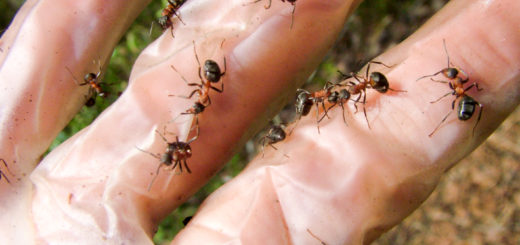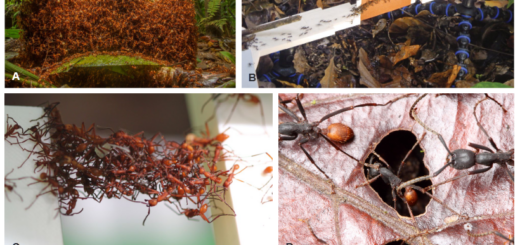Antennation and information
In their paper “No evidence for tactile communication of direction in foraging Lasius ants” published in Insectes Sociaux February 2018, Stefan Popp et al. test whether Lasius ants can communicate the directions to food by means of physical contact. In this Review, Duncan E. Jackson stresses the timeliness of the study and elaborates on qualifying thoughts already aired by the authors themselves.
A Review compiled by Duncan E. Jackson 
Encounters between ants are often accompanied by antennation where ants drum each other’s antennae in an apparently complex manner. The meanings of these antennal contacts have attracted the curiosity of researchers for many years. Roles for antennation have been determined in mating where prolonged antennation is a precursor to copulation in most Hymenoptera, as well as in many other insects such as bugs and crickets. Scott Powell and Walter Tschinkel showed (1999) that dominance behavior characterized by rapid antennation between workers is responsible for the establishment of the division of labor between nest workers and foragers in the ant Odontomachus brunneus. Ant workers also engage in antennation during recruitment to food sources in the African weaver ant, Oecophylla longinoda, and it precedes trophallaxis in many ant species.
Clearly, the antennae are used for chemoreception so they have an essential role in discriminating other ants to identify nestmates or conspecifics. However, the apparently complex nature of antennation has led to the suggestion that patterns of antennal taps can convey information encoded in an “antennal language.” Thus, Eric Wasmann (1899) interpreted antennal interactions as forming a language that plays an essential role in colony organization. We now know that pheromones have the most crucial functions in organization.
Perhaps the most extraordinary claim regarding antennation is that made by Zhanna Reznikova and her colleagues who reported that ants can convey complex sets of directions via antennation. This remarkable finding is not widely acknowledged by the research community, although further studies have been reported by Reznikova and colleagues. In a recent study, Popp et al. (2018) tested the possibility of antennation communicating information in two Lasius species (Lasius niger and Lasius neglectus) while carefully controlling for the possibility of pheromone trails providing informative cues. They found no evidence that ants with knowledge of the location of a food source in a T-maze could convey the correct direction, i.e., left or right, to ants without prior knowledge of the food source’s location. Thus, these two species appear to be incapable of conveying simple directional information by antennation, but why should they when both are capable of conveying the location of a food source with high accuracy by laying trail pheromones. Does this mean that the ants studied by Reznikova are special?
In their study, Popp et al. mentioned several reports by Reznikova and her team regarding their remarkable findings but they did not cite the earliest study from 1988 (Reznikova & Ryabko 1988), which presents the full methods employed to obtain their results. Reznikova suggested that ants can forage in trees and shrubs, and direct other ants in their team to specific rewarding locations by telling them the number of the branch to turn onto when walking up a plant. Obviously, this could be problematic because left and right are readily reversed when moving to the opposite orientation when walking on the surface of a three-dimensional structure like a plant. In their experimental set-up, Reznikova used a comb-like structure with 25 to 60 branches, which were all placed on the same side. A scout ant was placed on the branch with a food source and allowed to return to make contact with other workers. During the period when the scout made contact with other workers, the test structure was replaced. Reznikova stated that the test species (Formica polyctena) is not known to lay pheromone trails, but Henquell and Abdi (1981) have shown that this species generally uses chemical trails in addition to visual orientation. Thus, the replacement of the test structure excluded the possibility of pheromone trails explaining Reznikova’s results. The recruited ants went to the correct branch in 99 out of 130 cases when only 25 branches were present and they only failed to go straight to the correct branch when the branch number exceeded 12. In order to eliminate the possibility that distance was being communicated, a circular structure with branches was also tested and the results were similar. It has been shown that Cataglyphis fortis can count its steps when foraging (Wittlinger & al. 2006), so it was important to eliminate the possibility of conveying distance information. The branch number was also proportional to the time spent antennating.
The problem of right and left losing meaning in a three-dimensional environment might be explained by the remarkable fact that all ants moved in a counter-clockwise direction in the circular set-up according to Reznikova. Many other animals exhibit handedness, and this might ensure reliable orientation to reach the correct branch of a tree or shrub in F. polyctena. Clearly, the set-up tested by Popp et al. is very different from that used by Reznikova and the question asked was apparently much simpler, but the two Lasius species failed to solve the problem by communicating left or right. A better test would involve the same species and the actual set-up used by Reznikova, before testing alternative mazes. Thus, although Popp et al. found no evidence of the communication of left or right in a simple maze, they did not test the same putative behavior reported by Reznikova who made no claim that right or left could be communicated. If F. polyctena descends a plant in a counter-clockwise manner and counts the branches passed on the way down, then it is not a case of communicating left or right but simply the number of the correct branch. However, it is not clear why F. polyctena might employ such a complex system when it has access to effective trail pheromones, although trail laying may be much more time consuming than returning quickly and communicating a number. Future studies should try to investigate this behavior with a more appropriate experimental set-up. The use of counting by ants and their possible handedness also merit further investigation.
References
Henquell, D. & Abdi, H. 1981: Influence respective des repères visuels et des repères chimiques dans l’orientation de Formica polyctena au cours de l’exploitation d’une source de nourriture. – Insectes Sociaux 28: 47-66.
Popp, S., Buckham-Bonnett, P., Evison, S.E.F., Robinson, E.J.H. & Czaczkes, T.J. 2018: No evidence for tactile communication of direction in foraging Lasius ants. – Insectes Sociaux 65: 37-46.
Powell, S. & Tschinkel, W.R. 1999: Ritualized conflict in Odontomachus brunneus and the generation of interaction-based task allocation: a new organizational mechanism in ants. – Animal Behavior 58: 965-972.
Reznikova, Z.I. & Ryabko, B.Y. 1988: Experimental Proof of the Use of Numerals in the Language of Ants. – Problemy Peredachi Informatsii 24: 97-101.
Wasmann, E. 1899: Die psychischen Fähigkeiten der Ameisen. – Zoologica, Stuttgart 11: 1-133.
Wittlinger, M., Wehner, R. & Wolf, H. 2006: The ant odometer: stepping on stilts and stumps. – Science 312: 1965-1967.
Original “ant” image by © Aleksey Gnilenkov under CC by 2.0





Popp et al. (2018) attempt to make a rather trivial finding on the lack of antennal communication in Lasius ants more interesting by presenting it as contrasting if not outright contradicting our with Ryabko earlier results. In reality, there is no contrast or contradiction, simply because the results concern different species. The fact that chickens don’t fly doesn’t contradict the fact that storks fly thousands of kilometers. Moreover, I’ve been repeating for years in my papers and conference talks that trail-laying mass-recruiting species do not transmit information about food sources by antennation; in particular, I reported a negative result to this effect on Myrmica rubra (see: Reznikova and Ryabko 1994; Reznikova 2008, 2017). We did not conduct any such experiments with Lasius ants because the result would have been obvious to us (and to any myrmecologist).
References
Reznikova, Zh., Ryabko B. (1994). Experimental study of the ants’ communication system with the application of the Information Theory approach. Memorabilia Zoologica, 48, 219-236.
Reznikova, Zh. (2008). Experimental paradigms for studying cognition and communication in ants (Hymenoptera: Formicidae). Myrmecological News, 11, 201-214.
Reznikova, Zh. (2017). Studying Animal Language Without Translation: An Insight From Ants. Springer, Switzerland.